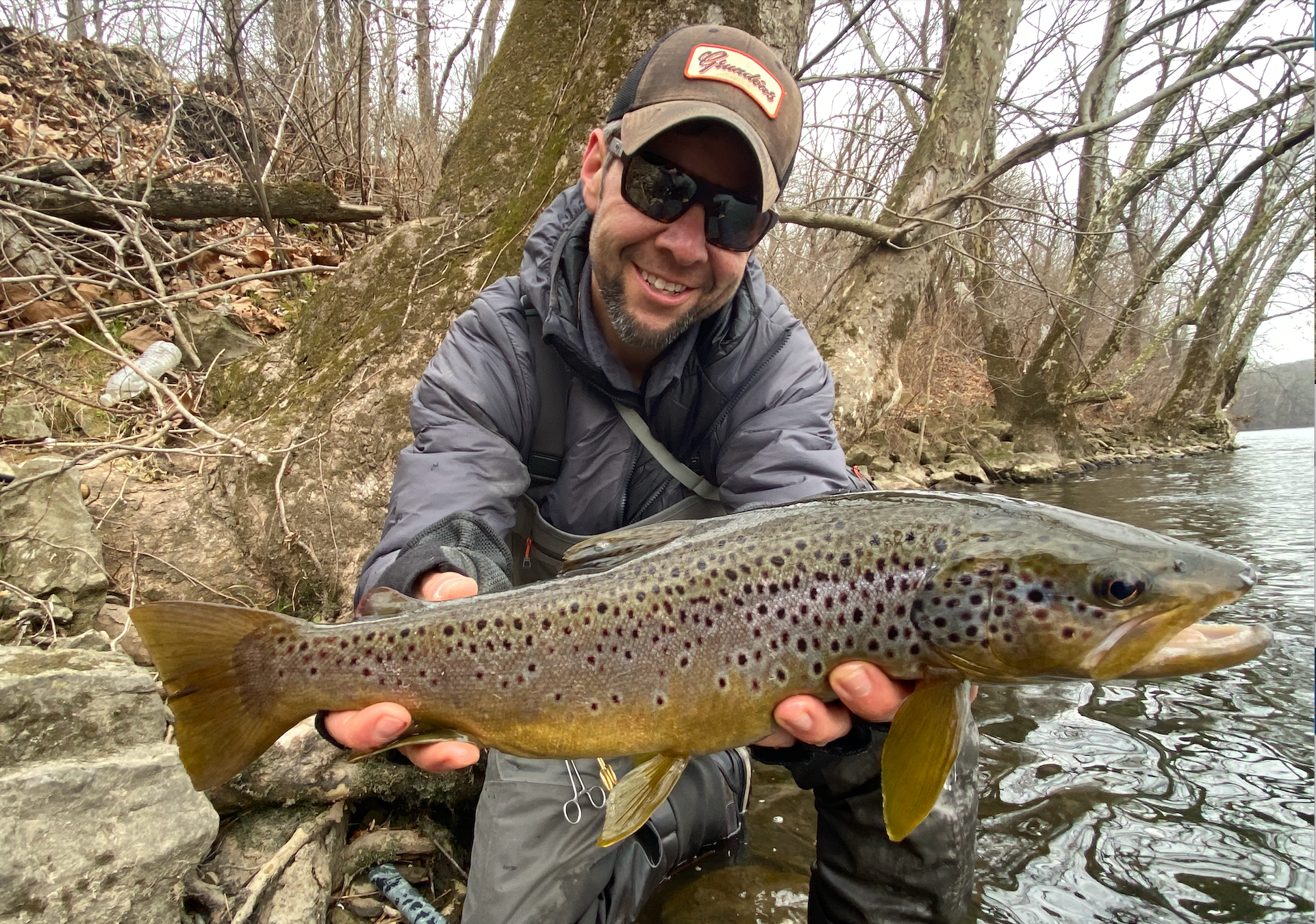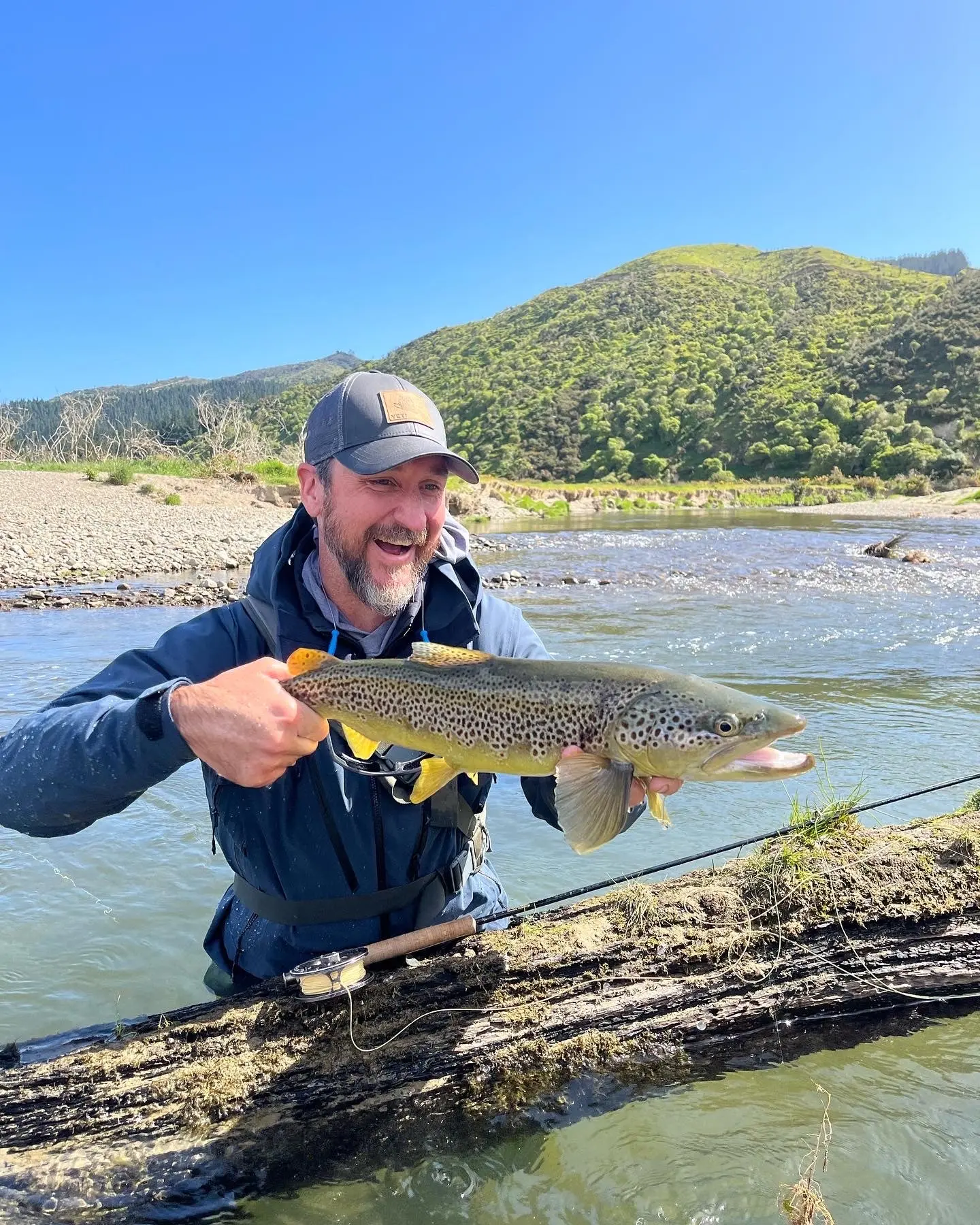Editor’s Note: Below, F&S fishing editor and eastern angler Joe Cermele and his western buddy, guide and writer Miles Nolte, hash it out, with no holds barred.
The Case for the East

Joe Cermele with big brown trout, taken from an unnamed eastern river. Joe Cermele
I couldn’t, in good conscience, make the claim that Eastern fly fishermen are better at catching trout than Western fly anglers. When you really break it down, you can either present a nymph, dry, or streamer well enough for a fish to take it or you can’t. What I can claim, though, is that anyone from the West that says it took years to hone those skills is full of sh*t.
The hill I am willing to die on is that if Montana, Colorado, Idaho, or Wyoming is your backyard, you have it easy. Yeah, we East Coast boys might not beat you in a distance casting competition and certainly not in a rowing competition, but give us a situation where the fishing is tough, when it forces you to really think about your approach, and we’ll dominate. Why? Because we’re not spoiled.
If there’s a piss trickle running behind a gas station in Western Montana, it holds wild trout. Grocery shopping in Western Colorado? Load your bags into the Subaru and go catch a nice wild rainbow in that stream flowing down the road from the Whole Foods. As for the average stream behind the Stop & Save where I live in Pennsylvania? Chubs and tires. That’s what I’ve got. Sure, there are famous eastern rivers like the Delaware, Battenkill, Penns Creek, and Allegheny, all known for big, wild browns, but compared to the West, there are very few potatoes between those prime cuts of meat. The Madison and Green and Clark Fork are all super crowded these days, I get it, but I don’t know a single Western angler who doesn’t have a bunch of less-pressured B and C rivers and streams to fish when we East Coast tourists are out there clogging up the main arteries. Within just a few counties and a couple hours drive in Montana alone, you’ve got as much quality wild trout water as all the Northeast states combined.
In the East, if it’s big, wild “butter” you crave, you’re either duking it out with everyone else from Philly, New York, or Boston on a destination river or you’re fighting with the locals on less-famous (and lesser) waters. Otherwise, you’re settling for stocked trout or tiny wild brookies. The former, while culturally significant, don’t really count in this debate, and while the brookies are neat and all, most people don’t want to hike to remote places to catch them. Besides, flinging 6-inch trout out of the water when you set the hook is no consolation prize for a 20-inch wild brown sipping a caddis. If, that is, you’re even lucky enough to find one sipping at all.
Wild Eastern trout are more wary and selective than Western fish. Much of that, I believe, is a product of pressure. However, it’s also science. Growing up fishing the rivers of Northeastern Pennsylvania, rising fish were a luxury. Not only was it harder to count on hatches, but even when they were happening, it didn’t mean the fish would tune in. So you had the learn how to nymph or get scratched. The concept of throwing dry flies blind doesn’t apply the same here as it does in the West, because unless you get really lucky, you can assume if there are zero fish rising, you’re not likely to change one’s mind.
The first time I ever fished Montana, I was shocked. Our guide tied on a big foam Stimulator for 18-year-old me. “There ya, go, bud,” he said. “Get after it.” After what?, I thought. I didn’t see anything rising. Anywhere I laid that fly in the Gallatin, a fat rainbow or cutthroat would come up and slurp it. Some of those drifts were terrible, too, and they still took it. All these years later and after many more trips out West, I understand that it’s not always that easy, but it is that easy way, way more often in the West, and the more opportunity you have to get flies in front of willing fish, the faster you learn how to catch them—and the less you have to earn it, dare I say.
I think about that first trip out West, and all the others where hopper patterns got blasted left and right, and the times there when I barely changed fly patterns all day. Then I compare that to fishing my beloved Delaware River in New York, one of the East’s best, where I might have to change patterns five times on one fish. I could never count the number of days I’ve had on the Delaware where we get one or two chances at a rising fish in a full day’s float. And then it’s, Don’t mess up because this could be your only shot. Cast now? No. No, wait for him to come up again. Now? No, make sure he’s not moving within the lane. Oh god, the pressure!
I’ve never felt that pressure on a Western river. Maybe it’s because I know with so many more trout per square mile, I’m likely to move more fish or get more shots at sippers. Maybe it’s because even if I whiff the browns, I’ll at least smack 25 cutties. But no matter what the river throws at me in the West I’m not worried about it because I cut my teeth on East Coast trout, dammit, at not a one of them was fooled by a dry fly so big it could double as a bath toy (except when throwing mouse flies in the dark, which we’re better at, too).
My very good friend and veteran Montana guide, Miles Nolte, is now going to grab the mic and try to poke holes in everything I said, but I want you to consider something before reading on: He now lives in New Zealand. Did he really move his entire family there because his wife got an incredible job offer, and it’s a once-in-a-lifetime opportunity to live in a gorgeous country and experience its beautiful people and culture? Or had fishing in Montana gotten so easy he needed to challenge himself on the most technical trout streams in the world? I have my opinion, but I’ll let you formulate your own.
The Case for the West

Miles Nolte with a big brown of his own, but this one taken from a western stream. Miles Nolte
If I had to describe East Coast fly anglers in a word, that word would be INSUFFERABLE. I know we’re supposed to be debating which anglers are better, East or West, and that most people will interpret angling prowess as the crux of this debate, but here’s the thing: I don’t choose my fishing buddies based on who can throw the tightest loop, execute the most complicated tuck cast, or put an Adams into a teacup at 70 feet. My favorite anglers are the ones with whom I enjoy spending 12 straight hours. I have some close fishing buds on the right coast, Joe included, but on the whole you all are annoying to fish with. You may be great people, but you overestimate both the greenery of the trout on the other side of the plains, and your own skill.
Joe just made that point for me. Experienced Western trout anglers were either cringing or shaking their heads in disbelief through Joe’s entire diatribe, especially the guides. The only evidence Joe presented that Western trout fishing is easier than Eastern seems to be based on one day of fishing. Except, the day he describes on the Gallatin is more an aberration than real life. I fished and guided that area for two decades, including the Gallatin, and guess what? I never once experienced what Joe’s describing. Not one single time.
I’m not calling Joe a liar. I believe him, but what he’s doing there—reinforcing the myth that coming out West means entering a Shangri-La of giant trout that rise to every cast—that’s a big part of the reason East Coast fly anglers are so insufferable. They all show up with unrealistic expectations, and when those expectations crash against the rocks of reality, guess who they blame? Everybody but themselves. Usually, they blame the guides. Even if they didn’t hire guides, they still blame the guides. Or the locals. Or the shop kid who told them where to go. They blame anyone and everyone they can think of, but it never even occurs to them that maybe the reason they’re not catching sh*t is that the fishing just isn’t very good that week, or they’re not skilled enough to get it done. They’ve caught a fish on the Delaware (or wherever), so any failure they experience chasing Western trout can’t possibly be their own fault. They’re Eastern fly anglers; these stupid Western trout should all just bow to their greatness.
We Westerners can play the small sample size game too, you know. I’ve fished the Delaware, twice. Every single time I went there, I found and caught rising trout. How about the Battenkill? I fished it (for two hours) and caught every single trout I saw—all on dries. If I divide the number of fish caught on dry flies by the number of hours fished on East Coast rivers, and compare that to the same figure from decades of fishing in Montana, I could mathematically prove that the dry fly fishing is far superior in New York State.
But I’m not going to do that, because that would be stupid.
The problem stems from the West’s mythology (see above). A great day or two of fishing in Montana, or Colorado, or Wyoming, will confirm a visiting Easterner’s hypothesis. Whereas, if I have a few great days of big fish sipping mayflies on the East Coast, I don’t assume I’ve found trout heaven, because I don’t have a preconceived notion to validate.
During my many years of guiding out West, people sometimes asked about the worst clients. (Manhattan attorneys, hands down.) If forced to generalize, I’d say people from the dense cluster of humanity from Washington D.C. to Boston tended to give me my most challenging days on the water. I’m sure most of them are perfectly nice people, but the combined weight of their expectations and egos often threatened to capsize the boat. When you show up anticipating 20-inch fish blindly gobbling giant dry flies at every rock and seam, you’re bound for disappointment, and disappointed anglers are not fun.
For the record, I’m also not convinced that Eastern anglers are actually as good as they think they are. I’m sure catching pellet-heads that manage to overwinter in urban streams among chubs and tires demands a certain level of grit. But just because you’re dogged enough to score the terrified palomino that survived 17 snagging attempts that day, doesn’t necessarily translate to fooling giant, wild rainbows on the Harriman Ranch.
There are plenty of talented anglers from the Atlantic side of the U.S., and I agree that you have fewer options when it comes to fly fishing for trout. The thing is, you’re not as good as you think you are, and the fishing out West isn’t as easy as you assume it to be. Those misconceptions don’t necessarily make you “worse” than your Western counterparts, they just make you more annoying.


